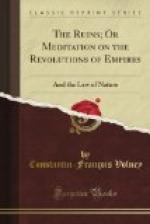“That the woman tempted him by offering him fruit fair to the sight and good to eat, which gave the knowledge of good and evil.
“And in fact, the Virgin holds in her hand a branch of fruit, which she seems to offer to the Herdsman; and the branch, emblem of autumn, placed in the picture of Mithra* between winter and summer, seems to open the door and give knowledge, the key of good and evil.
* See this picture in Hyde, page 111, edition of 1760.
That this couple had been driven from the celestial garden, and that a cherub with a flaming sword had been placed at the gate to guard it.
“And in fact, when the virgin and the herdsman fall beneath the horizon, Perseus rises on the other side;* and this Genius, with a sword in his hand, seems to drive them from the summer heaven, the garden and dominion of fruits and flowers.
* Rather the head of Medusa; that head of a woman once so beautiful, which Perseus cut off and which beholds in his hand, is only that of the virgin, whose head sinks below the horizon at the very moment that Perseus rises; and the serpents which surround it are Orphiucus and the Polar Dragon, who then occupy the zenith. This shows us in what manner the ancients composed all their figures and fables. They took such constellations as they found at the same time on the circle of the horizon, and collecting the different parts, they formed groups which served them as an almanac in hieroglyphic characters. Such is the secret of all their pictures, and the solution of all their mythological monsters. The virgin is also Andromeda, delivered by Perseus from the whale that pursues her (pro-sequitor).
That of this virgin should be born, spring up, an offspring, a child, who should bruise the head of the serpent, and deliver the world from sin.
“This denotes the son, which, at the moment of the winter solstice, precisely when the Persian Magi drew the horoscope of the new year, was placed on the bosom of the Virgin, rising heliacally in the eastern horizon; on this account he was figured in their astrological pictures under the form of a child suckled by a chaste virgin,* and became afterwards, at the vernal equinox, the ram, or the lamb, triumphant over the constellation of the Serpent, which disappeared from the skies.
* Such was the picture of the Persian sphere, cited by Aben Ezra in the Coelam Poeticum of Blaeu, p. 71. “The picture of the first decan of the Virgin,” says that writer. “represents a beautiful virgin with flowing hair; sitting in a chair, with two ears of corn in her hand, and suckling an infant, called Jesus by some nations, and Christ in Greek.”
In the library of the king of France is a manuscript in Arabic, marked 1165, in which is a picture of the twelve signs; and that of the Virgin represents a young woman with an infant by her side: the whole scene indeed of the birth




